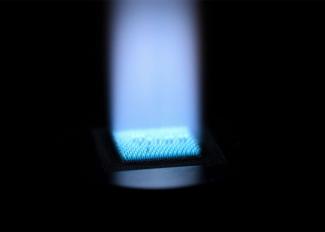Researchers in NETL’s Fundamental Combustion Laboratory (FCL) have developed advanced diagnostic techniques that are providing accurate, real-world data to validate models of next-generation fossil fuel and combustible renewable (i.e., hydrogen) technologies like direct power extraction (DPE) systems and rotating detonation engines (RDE). As the models become more refined, these technologies can be efficiently designed and deployed to realize significant performance benefits, which will help to reduce greenhouse gas emissions and provide more affordable and reliable energy for the nation.
“The diagnostic techniques we’ve developed are unique in that they are very application-specific,” Clint Bedick, Ph.D., who works in the FCL, said. “Whether it’s finding ways of measuring the intense heat and electrical conductivity of an oxy-combustion flame or recording an RDE shock wave that lasts only milliseconds, we tailor our approach for the specific environments in which we’ll be measuring.”
The most cutting-edge fossil-energy technologies also generally have the most extreme environments, making measurements difficult or impossible with traditional tools and techniques. A normal thermocouple, for example, would melt in the 3000°-Kelvin heat involved in DPE; however, laser diagnostic techniques developed in the FCL can provide accurate, unobtrusive measurements even in such high-temperature conditions.
A DPE system converts the kinetic and thermal energy of an electrically conductive fluid into electricity by driving it through a strong magnetic field. One form of DPE is magnetohydrodynamics (MHD), and NETL is leading in MHD power generation research thanks, in part, to the measurements Bedick and his colleagues are making in the FCL.
“Electrical conductivity is key to DPE technologies,” said Bedick. “The combustion process is ‘seeded’ with potassium to increase the conductivity, which we can then measure with laser-based probes and spectroscopy techniques to see how they line up with the computational models.”
Measurements made in the FLC also support the development of an RDE — a promising technology that is more mechanically simple than a traditional combustion engine and can theoretically achieve much higher efficiencies. However, RDEs react the fuel and oxidizer through detonation, which creates a complex environment that can be challenging to model as well as accurately measure performance characteristics.
“When most people think of detonations, they think of explosives,” Bedick said. “We want to harness that power for energy production, but we need accurate models to figure out how to best achieve this.”
Currently, most research RDEs require highly restrictive inlets to mitigate interruption of fuel and air as the high-pressure detonation wave passes by. However, this level of inlet restriction reduces the overall ability of the system to operate at its full potential.
“To analyze new inlet designs, we set up a lab-scale experimental testing platform featuring high-speed cameras that can record up to a hundred thousand frames per second,” said Andy Tulgestke, Ph.D., a research associate in the FLC through the Oak Ridge Institute for Science and Education (ORISE) program. “The cameras capture the supersonic detonation waves as they interact with the inlet..”
Data gathered from the testing platform has helped quantify the physical parameters that define the process and will allow engineers to design new geometrical approaches for more efficient inlets.
“Just a decade ago, diagnostic techniques weren’t fast or accurate enough to provide the kind of high-fidelity data needed to understand and model RDEs,” Bedick said. “Today, NETL is working towards more and more accurate models based on the measurements we are able to provide, and an optimized RDE is that much closer to becoming a reality.”
DPE and RDE technologies share the ability to realize much higher gains in efficiency than current combustion technologies. While an increase of a few tenths of a percentage point is a significant advancement in traditional power generation based on fossil fuel and combustible renewables, DPE and RDE technologies could increase efficiencies by 5-10%, realizing transformational gains that could change the way power producers create energy. Research in the FCL is another example of how NETL is discovering, integrating and maturing technology solutions to enhance the nation’s energy foundation and protect the environment for future generations.




